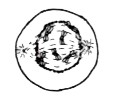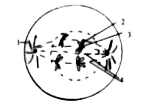In oogenesis, all divisions are mitotic except during the formation of
oogonia
primary oocytes
first polar body
second polar body
The correct Answer is:C
Step-by-Step Solution:
1. Understanding Oogenesis: Oogenesis is the process of egg (ovum) formation in females. It involves several stages, starting from the formation of oogonia to the development of mature ova.
2. Identifying the Types of Cell Division: In oogenesis, there are two types of cell division:
- Mitosis: This is a type of cell division that results in two identical daughter cells. It occurs during the formation of oogonia and primary oocytes.
- Meiosis: This is a specialized type of cell division that reduces the chromosome number by half and results in the formation of gametes. It occurs during the formation of secondary oocytes and polar bodies.
3. Formation of Oogonia: Oogonia are the initial cells formed in the ovaries. They are produced through mitotic divisions. Therefore, the formation of oogonia involves mitosis.
4. Formation of Primary Oocytes: Primary oocytes are formed from oogonia through mitotic division. Thus, this stage also involves mitosis.
5. Meiotic Division: The primary oocyte undergoes meiosis to form a secondary oocyte and the first polar body. This is the key step where meiosis occurs.
6. Polar Bodies Formation: The first polar body is formed during the meiotic division of the primary oocyte. The second polar body is also formed during the second meiotic division of the secondary oocyte, but it is not the focus of the question.
7. Conclusion: Among the options provided, the only division that is not mitotic is during the formation of the first polar body, which is produced through meiosis.
Final Answer:
In oogenesis, all divisions are mitotic except during the formation of the first polar body.
---
- Mitosis: This is a type of cell division that results in two identical daughter cells. It occurs during the formation of oogonia and primary oocytes.
- Meiosis: This is a specialized type of cell division that reduces the chromosome number by half and results in the formation of gametes. It occurs during the formation of secondary oocytes and polar bodies.
In oogenesis, all divisions are mitotic except during the formation of the first polar body.
Topper's Solved these Questions
- HUMAN REPRODUCTION BOOK - VMC MODULES ENGLISHCHAPTER - HUMAN REPRODUCTION EXERCISE - IN-CHAPTER EXERCISE-C
10 Videos
- HUMAN REPRODUCTION BOOK - VMC MODULES ENGLISHCHAPTER - HUMAN REPRODUCTION EXERCISE - IN-CHAPTER EXERCISE-A
10 Videos
- HUMAN HEALTH AND DISEASEBOOK - VMC MODULES ENGLISHCHAPTER - HUMAN HEALTH AND DISEASEEXERCISE - IMPECCABLE
54 Videos
- MICROBES IN HUMAN WELFAREBOOK - VMC MODULES ENGLISHCHAPTER - MICROBES IN HUMAN WELFAREEXERCISE - IN - CHAPTER EXERCISE - B
19 Videos
Similar Questions
Knowledge Check
During spermatogenesis, the second maturation division results in the formation of:
A8 haploid spermatidsB2 diploid spermatidsC4 haploid spermatidsD4 haploid spermatidsIn animals meiotic division occurs during gamete formation. This gametic meiosis results in
Ahaplontic life cycleBdiplontic life cycleCdiplohaplontic life cycleDnone of these
Type of divisions that occurs during formation of megaspore is
View SolutionThe given diagram shows a stage during mitotic division in an animal cell:

Name the type of cell division that occurs during:
A. Growth of a shoot
B. Formation of pollen grains.
View SolutionWhich of following mineral element is needed during the formation of mitotic spindle, accumulates in older leaves & is involved in normal functioning of cell membrane?
View Solution[A] : In Selaginella/Pteris reduction division occurs during microspore formation only .
[R] : It was first shown by Zacharis and Strasburger in 1963 .
View Solutionall of the following characteristics are essential for the formation of seeds except
View SolutionGiven diagram representing a stage during mitotic cell division in an animal cell:

What is the function of part 3?
View Solution